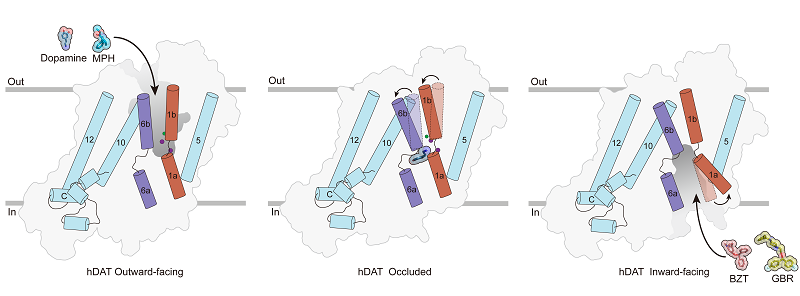
Dopamine is the most abundant catecholamine neurotransmitter in the brain. Many mental disorders, such as depression, bipolar disorder, Parkinson's disease, and attention deficit hyperactivity disorder, are associated with abnormal dopamine levels. Dopamine transporter (DAT) is responsible for recycling dopamine from the synaptic cleft into presynaptic neurons, maintaining the homeostasis of dopamine in the central nervous system.
A recent research led by Prof. ZHAO Yan from the Institute of Biophysics of the Chinese Academy of Sciences revealed for the first time the three conformations during the transport process of human DAT, identified the substrate binding sites and ion binding sites of human DAT, and intuitively explained the coupling relationship between ion binding and substrate transport.
Their study was published in Nature on August 7.
ZHAO's team used single-particle cryo-electron microscopy to resolve five high-resolution structures of human dopamine transporter DAT: apo-, dopamine-bound, ADHD drug methylphenidate-bound, inhibitor GBR12909-bound, and Benztropine-bound in their study, and elucidated the substrate recognition mechanism and conformational transition mechanism of DAT ion-coupling, as well as the differences in binding modes between addictive and non-addictive drugs.
The researchers found that DAT undergoes three states of outward-facing, occluded, and inward-facing under the drive of sodium and chloride ions for the transmembrane transport of dopamine. They resolved the occluded-state structure of DAT bound to dopamine at a resolution of 2.8 Å, with dopamine binding in the central pocket that is inaccessible from both the extracellular and intracellular sides.
The research team resolved the complex structure of methylphenidate bound to DAT for the first time, revealing its binding in the extracellular-facing pocket and extensive interactions with DAT.
In order to explore the key mechanisms of treating cocaine addiction, ZHAO and his team conducted in-depth studies on the binding modes of two potential drugs, GBR12909 and Benztropine, with DAT.
Their study found that GBR12909 and Benztropine stabilize DAT in an inward-facing conformation in different binding modes within the intracellular cavity. The preference for these different conformations may have a potential relationship with their different addictive properties.
This study illustrates the fine substrate recognition and conformational transition processes of human DAT during dopamine reuptake. It first clearly explains different binding modes of psychostimulant drugs and anti-psychostimulant drugs targeting DAT, providing important guidance for the development of drugs to treat DAT-related mental disorders.

Figure 1. Cryo-EM structures of human DAT in its apo state, bound to substrate dopamine, and complexes with three inhibitors. (Image by ZHAO Yan's group)

Figure 2. Schematic diagram for structures of hDAT. (Image by ZHAO Yan's group)

86-10-68597521 (day)
86-10-68597289 (night)

52 Sanlihe Rd., Xicheng District,
Beijing, China (100864)

